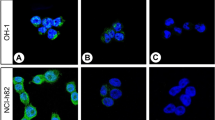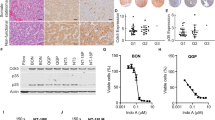Summary
A new human pancreatic cancer (HPAC) cell line was established from a nude mouse xenograft (CAP) of a primary human pancreatic ductal adenocarcinoma. In culture, HPAC cells form monolayers of morphologically heterogenous, polar epithelial cells, which synthesize carcinoembryonic antigen, CA 19-9, CA-125, cytokeratins, antigens for DU-PAN-2, HMFG1, and AUA1, but do not express chromogranin A or vimentin indicative of their pancreatic ductal epithelial cell character. In the presence of serum, HPAC cell DNA synthesis was stimulated by insulin, insulin growth factor-I, epidermal growth factor, and TGF-α but inhibited by physiologic concentrations of hydrocortisone and dexamethasone. Dose-dependent inhibition of DNA synthesis was limited to steroids with glucocorticoid activity. The inhibitory effect of dexamethasone was abolished by the glucocorticoid antagonist RU 38486. Binding of [3H]dexamethasone to cytosolic proteins was specific and saturable at 4° C. Scatchard analysis of binding data demonstrated a single class of high-affinity binding sites (Kd=3.8±0.9 nM; Bmax=523±128 fmol/mg protein). Western blot analysis revealed a major protein band that migrated at a Mr of 96 kDa. Northern blot analysis identified an mRNA of approximately 7 kilobases which hybridized with a specific glucocorticoid receptor complementary DNA probe (OB7). These findings support a role for glucocorticoids in the regulation of human malignant pancreatic cell function.
Similar content being viewed by others
References
Andren-Sandberg, A. Steroid receptors in pancreatic cancer, a review. In: Preece, P. E.; Cuschieri, A.; Rosin, R. D., eds. Cancer of the bile ducts and pancreas. Philadelphia, PA: W. B. Saunders, Co.; 1989.
Arklie, J. Studies of human epithelial cell surface using monoclonal antibodies. D. Phil. England: Oxford Univ.; 1981. Dissertation.
Beauchamp, R. D.; Lyons, R. M.; Yang, E. Y., et al. Expression of and response to growth regulatory peptides by two human pancreatic carcinoma cell lines. Pancreas 5:369–380; 1990.
Benz, C.; Hollander, C.; Miller, B. Endocrine-responsive pancreatic carcinoma: steroid binding and cytotoxicity studies in human tumor cell lines. Cancer Res. 46:2276–2281; 1986.
Borowitz, M. J.; Tuck, F. L.; Sindelar, W. F., et al. Monoclonal antibodies against pancreatic adenocarcinoma: distribution of DU-PAN-2 antigen on glandular epithelia and adenocarcinomas. JNCI 72:999–1005; 1984.
Brons, G.; Newby, A. C.; Hales, C. N. Glucocorticoids stimulate the division of rat pancreatic islet tumor cells in tissue culture. Diabetologia 27:540–544; 1984.
Burnstein, K. L.; Bellingham, D. L.; Jewell, C. M., et al. Autoregulation of glucocorticoid receptor gene expression. Steroids 56:52–58; 1991.
Cidlowski, J. A.; Michaels, G. A. Alteration in glucocorticoid binding site number during the cell cycle in HeLa cells. Nature 266:643–645; 1977.
Dexter, D. L.; Matook, G. M.; Meitner, P. A., et al. Establishment and characterization of two human pancreatic cancer cell lines tumorigenic in athymic mice. Cancer Res. 42:2705–2714; 1982.
DiSorbo, D. M. Effect of triamcinolone acetonide on the growth of NEL-M1 human melanoma cells cultured in the presence and absence of growth stimulatory agents. Cancer Res. 46:3964–3968; 1986.
Evans, R. M. The steroid and thyroid hormone receptor superfamily. Science 240:889–895; 1985.
Frazier, M. L.; Pathak, S.; Wang, Z-W., et al. Establishment of a new human pancreatic adenocarcinoma cell line, MDAPanc-3. Pancreas 5:8–16; 1990.
Gomi, M.; Moriwaki, K.; Katagiri, S., et al. Glucocorticoid effects on myeloma cells in culture: correlation of growth inhibition with induction of glucocorticoid receptor messenger RNA. Cancer Res, 50:1873–1878; 1990.
Gower, W. R., Jr.; Ellison, E. C.; Knierim, T. H., et al. Gastrinoma in vitro: morphological and physiological studies of primary cell cultures. Gastroenterology 98:936–954; 1990.
Guthrie, J.; Williams, J. A.; Logsdon, C. D. Growth and differentiation of pancreatic acinar cells: independent effects of glucocorticoids on AR42J cells. Pancreas 6:506–513; 1991.
Harmon, J. M.; Elsasser, M. S.; Eisen, L. P., et al. Glucocorticoid receptor expression in receptorless mutants isolated from the human leukemic cell line CEM-C7. Mol. Endocrinol. 3:734–743; 1989.
Hollenberg, S. M.; Weinberger, C.; Ong, E. S., et al. Primary structure and expression of a functional human glucocorticoid receptor cDNA. Nature 318:635–641; 1985.
Kapuscinski, J.; Skoczylas, B. Simple and rapid fluorimetric method form DNA microassay. Anal. Biochem. 83:252–257; 1977.
Klöppel, G. Cancer of the pancreas: morphological and biological aspects. In: Preece, P. E.; Cuschieri, A.; Rosin, R. D., eds. Cancer of the bile ducts and pancreas. Philadelphia, PA: W. B. Saunders, Co.; 1989.
Korc, M.; Meltzer, P.; Trent, J. Enhanced expression of epidermal growth factor receptor correlates with alterations of chromosome 7 in human pancreatic cancer. Proc. Natl. Acad. Sci. USA 83:5141–5144; 1986.
Kyriazis, A. P.; Kyriazis, A. A.; Scarpelli, D. G., et al. Human pancreatic adenocarcinoma line Capan-1 in tissue culture and the nude mouse. Am. J. Pathol. 106:250–260; 1982.
Kyriazis, A. A.; Kyriazis, A. P.; Sternberg, C. N., et al. Morphological, biological, biochemical, and karyotypic characteristics of human pancreatic ductal adenocarcinoma Capan-2 in tissue culture and the nude mouse. Cancer Res. 46:5810–5815; 1986.
Kyriazis, A. P.; McCombs, W. B.; Sandberg, A. A., et al. Establishment and characterization of human pancreatic carcinoma cell line SW-1990 in tissue culture and the nude mouse. Cancer Res. 43:4393–4401; 1983.
Liehr, R-M.; Melnykovych, G.; Solomon, T. E. Growth effects of regulatory peptides on human pancreatic lines PANC-1 and MIA PaCa-2. Gastrenterology 98:1666–1674; 1990.
Lippman, M. Clinical implications of glucocorticoid receptors in human leukemia. Am. J. Physiol. 243:E103-E108; 1982.
Logsdon, C. D.; Moessner, J.; Williams, J. A., et al. Glucocorticoids increase amylase mRNA levels, secretory organelles, and-secretion in pancreatic acinar AR42J cells. J. Cell Biol. 100:1200–1208; 1985.
Logsdon, C. D.; Williams, J. A. Pancreatic acini in short-term culture: regulation by EGF, carbachol, insulin, and corticosterone. Am. J. Physiol. 244:G675-G682; 1983.
Longnecker, D. S. Hormones and receptors in gastrointestinal malignancies. Digestion 46(suppl 2):92–98; 1990.
Moguilewsky, M.; Philibert, D. RU 38486: potent antiglucocorticoid activity correlated with strong binding to the cytosolic glucocorticoid receptor followed by impaired activation. J. Steroid Biochem. 20:271–276; 1984.
Montiel, F.; Ortiz-Caro, J.; Villa, A., et al. Glucocorticoids regulate insulin binding in a rat glial cell line. Endocrinology 121:258–265; 1987.
Oberg, K. C.; Carpenter, G. Dexamethasone acts as a negative regulator of epidermal growth factor receptor synthesis in fetal rat lung cells. Mol. Endocrinol. 3:915–922; 1989.
Ohmura, E.; Okada, M.; Onoda, N., et al. Insulin-like growth factor I and transforming growth factor α as autocrine growth factors in human pancreatic cancer cell growth. Cancer Res. 50:103–107; 1990.
Rao, K. V. S.; Williams, R. E.; Fox, C. F. Altered glucocorticoid binding and action in response to epidermal growth factor in HBL100 cells. Cancer Res. 47:5888–5893; 1987.
Rosewicz, S.; McDonald, A. R.; Maddux, B. A., et al. Mechanism of glucocorticoid receptor down-regulation by glucocorticoids. J. Biol. Chem. 263:2581–2584; 1988.
Rousseau, G. G.; Baxter, J. D.; Tomkins, G. M. Glucocorticoid receptors: relations between steroid binding and biological effects. J. Mol. Biol. 67:99–115; 1972.
Sandgren, E. P.; Quaife, C. J.; Paulovich, A. G., et al. Pancreatic tumor pathogenesis reflects the causative genetic lesion. Proc. Natl. Acad. Sci. USA 88:93–97; 1991.
Scatchard, G. The attraction of proteins for small molecules and ions. Ann. NY Acad. Sci 51:660–672; 1949.
Seabright, M. A. A rapid banding technique for human chromosomes. Lancet 2:971–972; 1971.
Smith, J. J.; Derynck, R.; Korc, M. Production of transforming growth factor α in human pancreatic cancer cells: evidence for a superagonist autocrine cycle. Proc. Natl. Acad. Sci. USA 83:7567–7570; 1986.
Srivastava, D.; Thompson, E. B. Two glucocorticoid binding sites on the human glucocorticoid receptor. Endocrinology 127:1770–1778; 1990.
Svec, F.; Rudis, M. Glucocorticoid hormone receptors in rat pancreas. Biochim. Biophys. Acta 674:30–36; 1981.
Swarovsky, B.; Steinhilber, W.; Scheele, G. A., et al. Coupled induction of exocrine proteins and intracellular compartments involved in the secretory pathway in AR42J cells by glucocorticoids. Eur. J. Cell Biol. 47:101–111; 1988.
Takuma, T.; Nakanishi, M.; Takagi, Y., et al. Precocious differentiation of mouse parotid glands and pancreas induced by hormones. Biochim. Biophys. Acta 538:376–383; 1978.
Tan, M. H.; Nowak, N. J.; Loor, R., et al. Characterization of a new primary human pancreatic tumor line. Cancer Invest. 4:15–23; 1986.
Taylor-Papadimetriou, J.; Peterson, J. A.; Arklie, J., et al. Monoclonal antibodies to epithelium-specific components of milk fat globule membrane: production and reaction with cells in culture. Int. J. Cancer 28:17–21; 1981.
Towbin, H.; Staehelin, T.; Gordon, J. Electrophoretic transfer of proteins from polyacrylamide gels to nitrocellulose sheets: procedure and some applications. Proc. Natl. Acad. Sci. USA 76:4350–4354; 1979.
Webster, M. K.; Guthrie, J.; Firestone, G. L. Suppression of rat mammary tumor cell growthin vitro by glucocorticoids requires serum proteins: characterization of wild type and glucocorticoid-resistant epithelial tumor cells. J. Biol. Chem. 265:4831–4838; 1990.
Werlin, S. L.; Stefaniak, J. Effects of hydrocortisone and cholecystokinin-octapeptide on neonatal rat pancreas. J. Pediatr. Gastroenterol. Nutr. 1:591–595; 1982.
Author information
Authors and Affiliations
Rights and permissions
About this article
Cite this article
Gower, W.R., Risch, R.M., Godellas, C.V. et al. HPAC, a new human glucocorticoid-sensitive pancreatic ductal adenocarcinoma cell line. In Vitro Cell Dev Biol - Animal 30, 151–161 (1994). https://doi.org/10.1007/BF02631438
Received:
Accepted:
Issue Date:
DOI: https://doi.org/10.1007/BF02631438




